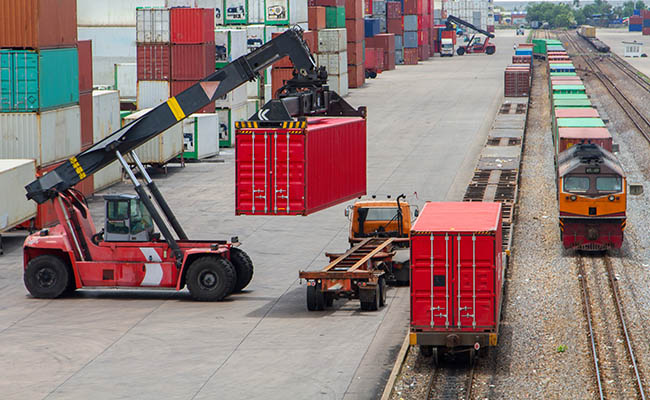
Rail Budget 2016: Infra investment, port connectivity & logistic measures get all-round applause
Rail-map for improving port connectivity will surely result in ease of doing business and lower transaction costs for traders, says Engineering Export Promotion Council Sai Nikesh | The Dollar Business
 Review of freight tariff policy to increase the share of railways vis-a-vis other modes of transport, coupled with other measures such as permit multi-point loading/ unloading, is expected to bring down logistics cost to the industry
Review of freight tariff policy to increase the share of railways vis-a-vis other modes of transport, coupled with other measures such as permit multi-point loading/ unloading, is expected to bring down logistics cost to the industryRail Budget 2016-17, released on Thursday, got an all-round applause as a passenger-centric, infrastructure-led and employment generating budget. In specific, Railway Minister’s announcements on expansion of freight basket, enhancement of port connectivity, infrastructure investments, among key others, seem to have wooed the industry. Let us see what key industry bodies and leading industry giants said on the Budget, which they termed as an industry-friendly one. What industry bodies said: Welcoming the Rail Budget 2016-17, Sumit Mazumder, President, Confederation of Indian Industry (CII), said the Minister has had to walk a tight rope to balance the Budget and finance investment plans. “In line with CII recommendations, the Rail Budget has provided a strong focus on augmenting investment, particularly in infrastructure. In particular, CII welcomes the announcements on development of three new freight corridors as well as the logistics parks and warehousing in PPP mode,” Sumit told The Dollar Business. Focus on R&D through setting up of SRESTHA, increasing the outlay of rail electrification by 50% and target to electrify 2000 kms, monetisation of soft assets, augmenting the speed of passenger and freight movement, are among other commendable initiatives that would help augment revenues, said CII President, giving a special applaud to the plan ‘envisaged to regain freight share’ for railways. “The review of tariff policy to evolve a competitive rate structure vis-à-vis other modes of transport should be used in this direction. At the same time, steps such as zero based costing, electricity at cheaper rates, delineation of responsibility to zonal railway etc would help reduce costs,” he added. For exporters in specific Engineering Export Promotion Council(EEPC), an apex body in the engineering segment lauded the Railway Budget for its measures on improving port connectivity, hoping that would enable a free movement for exporters. “The Railway Budget has clearly spelt out a rail-map for improving port connectivity that will surely result in ease of doing business and lower transaction costs for the exporters and importers,” T S Bhasin, Chairman of EEPC India, told The Dollar Business. Bhasin lauded the Ministry’s plan to connect ports of Nargol and Hazira under PPP mode. The connectivity to ports on the 7,517 km coastline by the Railways will yield positive results for the exporters who are always battling the issue of poor infrastructure, he noted. Development of Rail side logistics parks and warehousing in Public-Private Partnership (PPP) mode along with 10 goods sheds are among other positive measures in the Budget from the exporters’ perspective. “Setting up of India’s first rail auto hub in Chennai, development of cold storage facilities on vacant land near freight terminals would go a long way in helping the country’s internal and external trade and industry,” said the EEPC Chairman. India Inc. on Rail Budget: Industry experts from leading companies exuded confidence that the Railways Budget 2016-17 augurs well for domestic industry in terms of promoting indigeneity by way of in-time investments, easy freight movement, etc. They felt that the increased infrastructure investment in Railway sector will result in development of associated industries like steel, cement, coal and others. “Renewed vigour,” says Ravi Uppal, MD, Jindal Steel and Power Limited(JSPL), while terming ‘very heartening’ the government’s focus on developing railway infrastructure and targeting a capital expenditure of Rs.1.21 lakh crore for FY’17, an increase of 20% YoY. “Indigenous steel sector will be the beneficiary of the enhanced investments in railways and these developmental initiatives augur well for the industry, Ravi added. “Bodes well for cement and coal industries as a result of no hike in freight fares,” says Ajay Kapur, MD &CEO, Ambuja Cement Ltd. “We welcome the announcement on expanding the freight basket, wherein it is proposed to start a time-tabled freight container, parcel and special commodity trains (on a pilot basis), container sector that would be opened to all traffic (barring coal, specified mineral ores and part-loads) during the non-peak season. All existing terminals/ sheds would be granted access to container traffic, where feasible... The manufacturing sector will also benefit from rationalisation of the tariff structure - to undertake review of tariff policy to evolve a competitive rate structure vis-a-vis other modes, permit multi-point loading/ unloading and apply differentiated tariffs to increase utilization of alternate routes, explore possibility of signing long term tariff contracts with our key freight customers using pre-determined price escalation principles,” Ajay added. “Permitting multi-point loading/unloading will improve railways utilisation,” says T V Narendran, MD, Tata Steel Limited, while lauding the Ministry for its efforts to rationalise tariff structure by review of the tariff policy for creating a competitive structure. Narendran said the Steel Industry looks forward to an early review of the policy to make movement of bulk commodities competitive. “Given India’s goal to achieve double digit growth, we hope that Union budget will make further announcements in public infrastructure. We are confident that the timely execution of the initiatives announced in this budget will have a positive impact on all the sectors that are dependent on railways including Steel,” added Narendran. “Logistics costs for the industry would come down,” says M V S Rao, Jt. MD & CFO of JSW Steel. “Review of freight tariff policy to increase the share of railways vis-a-vis other modes of transport, coupled with other measures such as permit multi-point loading/ unloading, is expected to bring down logistics cost to the industry.” “Outlays on new dedicated freight corridors, port connectivity, suburban railway projects, metros, developing logistics parks and warehousing under PPP mode will augur well for steel demand. Even though there are several positives in the Railway budget that would benefit the industry in the medium term, the Railway minister should expedite the revision in tariff policy to make it competitive to the industry that not only increase volume and revenue to the Railways but also enable the Industry to be globally competitive," added Rao. “Railways will now move into the implementation phase to upgrade and modernize the entire system,” says Ajay S Shriram, Chairman and Senior MD of DCM Shriram Ltd. “The proposed capital expenditure, increase in commissioning of new lines, additional freight corridors and most importantly completion of existing projects, will not just increase the capacity of the railways but will improve the country's overall infrastructure and kick start the investment process and address the need to increase employment,” added Shirram.
February 26, 2016 | 4:50pm IST.






 to success.
to success.